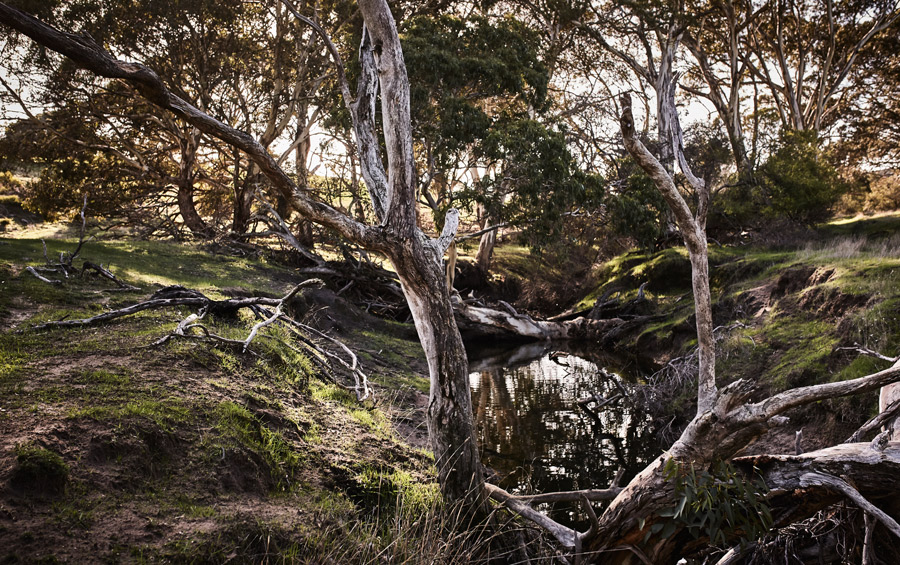Join the Mulloon Institute in the transformation and rehydration of Tidbinbilla Station, demonstrating a commitment to sustainable agriculture and environmental regeneration. This program will rehydrate and restore agricultural landscapes, building resilience to climatic extremes.
What is the opportunity?
Some agricultural landscapes have reduced capacity to retain and cycle water, increasing vulnerability to drought. This project will drive the adoption of two practices: Natural Infrastructure and Farm-System Solutions, proven to re-establish landscape function and enable producers to make better use of rainfall.
Natural infrastructure, including contours, brushpacks, and streamed control structures, can significantly enhance drought resilience by slowing and filtering water, while rehydrating vast areas and capturing nutrient-rich sediment. These systems improve soil health, boost plant growth, restore nutrient cycles, and increase water retention, leading to stronger plant and animal health. By combining these techniques with farm-system solutions like planned grazing and adaptive water management, farmers can build resilient, productive, diverse landscapes that thrive in the face of climate change.
Restoring natural function to the Tidbinbilla River is essential to promote positive environmental outcomes and improve water retention in the surrounding landscape. Stage 1 of the restoration is complete, but stages 2 and 3 need additional funding to ensure long-term sustainability and productivity of this vital landscape.
What is this project’s solution?
Landscape rehydration is a nature-based solution that uses natural materials, such as hardwood timber logs, rock, and coir matting, along with engineering techniques, to raise riverbed levels and slow stream velocity. This helps to reduce erosion and buffer against high flow events stabilising the river allowing for the restoration of natural function.
Mulloon Institute has helped Tidbinbilla Station owners design and implement natural infrastructure and farm system practices to enhance drought resilience, slow and infiltrate water flows, trap nutrient-rich sediment, and improve soil health by increasing soil carbon and microbial activity.
A further set of control structures are in development which are intended to assist with the restoration of a more significant section of Tidbinbilla River. Your contribution will significantly improve the ability of this site to be restored and provide inspiration to other landholders to adopt similar approaches to stream rehabilitation.
The installation of these interventions provides an opportunity for nature to repair the landscape at a faster rate, resulting in the following outcomes:
- establishment of diverse native vegetation along the channel
- extending baseflow duration and reducing incidences of cease-to-flow conditions
- buffering of flood peaks
- capture and storage of fine sediment
- increased carbon capture and storage
- enhanced aquatic and terrestrial habitat and connectivity
- increased agricultural production due to a more hydrated landscape producing quality biomass.
What is the investment ask?
The total cost to complete stages 2 and 3 will be approximately AU$200,000 (+GST)
The project can be completed within a 3-month period, subject to weather conditions and the availability of materials.

What are the benefits of involvement?
This project offers a unique opportunity to support a long-term woolgrower in demonstrating the benefits of landscape rehydration in a typical NSW Southern Tablelands setting. Supporting a motivated landholder to action meaningful landscape restoration work, allows you to demonstrate how sustainable wool production and landscape restoration go hand in hand.
Your support connects you to a positive, consumer-friendly story of sustainability, actively promoted through Woolmark and industry channels. Aligning with this initiative positions you as a leader in fostering resilient landscapes and sustainable practices within the wool industry.
What is your expected participation?
Mulloon Institute has a depth of experience in delivering on projects such as this. Mulloon has team members with technical and engineering skills to ensure projects are delivered safely, administrative staff to manage the project and financial governance, and a communications team to ensure the project is well publicised through social media channels.
Key Project Facilitator

How to get involved?
Schedule an initial meeting today to review project plans and understand the impact of your investment.
Please contact: Jono Forest - General Manager – Mulloon Institute
jono@mullooninstitute.org